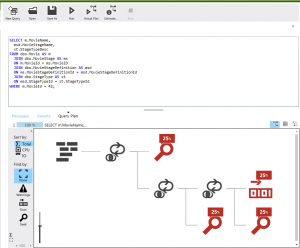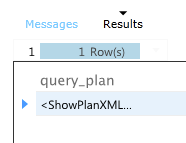In my previous post showing how to get to execution plans in the Database Management Portal, I showed that it’s pretty easy to put a query in a query window and get the execution plan. This allows you to understand query behavior in order to tune your T-SQL or your data structures, all through the Azure interface. But, what happens if you want to share an execution plan with a friend, post it to an online forum, save it for later comparisons as part of troubleshooting bad parameter sniffing, track behaviors over time as statistics change, other purposes that I can’t think of at the moment?
To first answer this question, let me tell you how you would do these things in SQL Server Management Studio (SSMS). First, and most obviously, when you look at the plan in SSMS you can just right click on that plan and select “Save Execution Plan As…” from the context menu. This will allow you to create a .sqlplan file on your OS. From there, do what you want. The file saved is XML, but the .sqlplan format is read by SSMS as a graphical plan. You can look at the underlying XML any time you want by right clicking and selecting the appropriate context menu.
And Azure SQL Database?
Well, things are a little different. Let’s start with the query. After you execute the query to get an actual plan or call up the estimated plan you’ll see the plan in the Portal.
You can see the query, the plan, and options with the plan (to be explored in a later post). If you right click on the plan as you would within SSMS, the context menu is singularly unhelpful since it will only have one option ‘Silverlight.’ (yes, we’re still running Silverlight in this part of Azure, don’t shoot the messenger). So I guess there’s no way to save that plan, right? Wrong. Look up at the top of the image above. You’ll see a button that looks like a 3.25″ floppy disk (kids, get granddad to explain what that is) and the phrase “Save As” underneath it. Click on that and you can save your query. Ah, but there’s a drop down under file types and there you’ll see “SQL Plan File.”
Provide a file name and you can save the execution plan down to your machine. Easy.
Ah, but there is a catch. Let’s say we query the Dynamic Management Objects to pull plans out of the cache. This query will run on both SQL Server and Azure SQL Database:
SELECTdeqp.query_plan FROMsys.dm_exec_query_stats AS deqs CROSS APPLY sys.dm_exec_query_plan(deqs.plan_handle) AS deqp CROSS APPLY sys.dm_exec_sql_text(deqs.sql_handle) AS dest WHEREdest.text LIKE 'SELECTm.MovieName, msd.MovieStageName, st.StageTypeDesc%';
The results, when run from SSMS, will look something like this:
That’s an embedded URL that you can click which will then open the execution plan from the cache. But, when the same query is run from SQL Database Management Portal, the results look like this:
No options for a clickable interface here to open the plans. You can try copying the output and then pasting it into Notepad then saving as a .sqlplan file. Of course, that’s only going to work for small plans since the result set here is not unlimited. You could build an app to query the cache and output to file. But, in general, querying directly to the plan cache from the SQL Database Management Portal gives you very few options for displaying your query plan.
Since this is such an important part of query tuning, here’s hoping that we get further enhancements to the Management Portal in the future.






